Negligence in Aircraft Refueling: A Business Law Case Study Analysis
VerifiedAdded on 2023/06/08
|6
|1308
|209
Case Study
AI Summary
This case study analyzes a negligence claim against Sam Speed, who provides aircraft refueling services at Albury Airport. The legal issues revolve around whether Sam was negligent in contaminating fuel, leading to damages to aircraft owned by White Ltd and Green Ltd, and losses suffered by a passenger of Blue Ltd, as well as damage to a Mercedes car parked nearby. The analysis applies principles of duty of care, breach of duty, and causation, referencing key cases such as Donoghue v Stevenson and relevant sections of the Civil Liability Act 2002. The conclusion assesses Sam's liability to each party, considering contributory negligence where applicable, and determines the extent of compensation he must provide. Desklib offers additional resources, including past papers and solved assignments, for students studying business law.
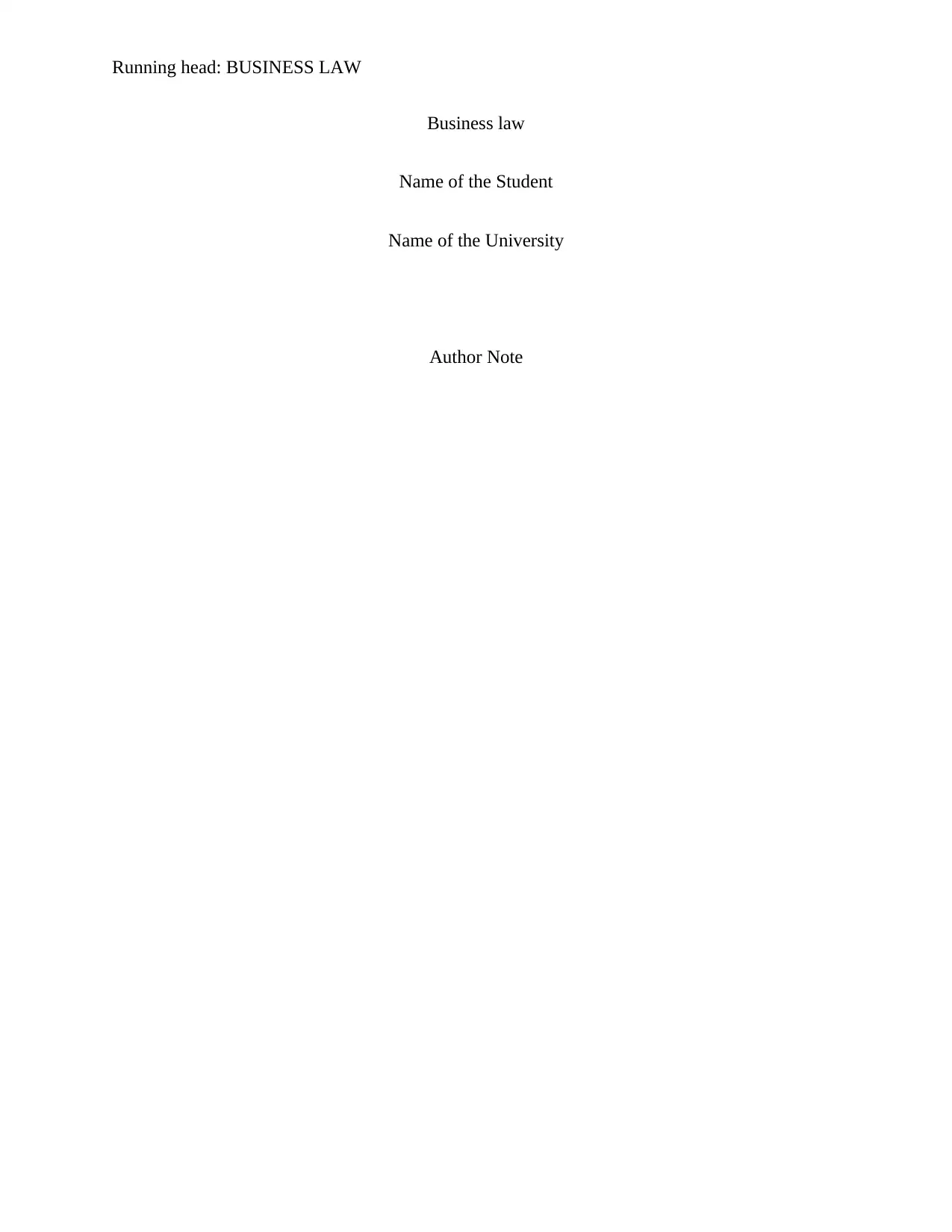
Running head: BUSINESS LAW
Business law
Name of the Student
Name of the University
Author Note
Business law
Name of the Student
Name of the University
Author Note
Paraphrase This Document
Need a fresh take? Get an instant paraphrase of this document with our AI Paraphraser
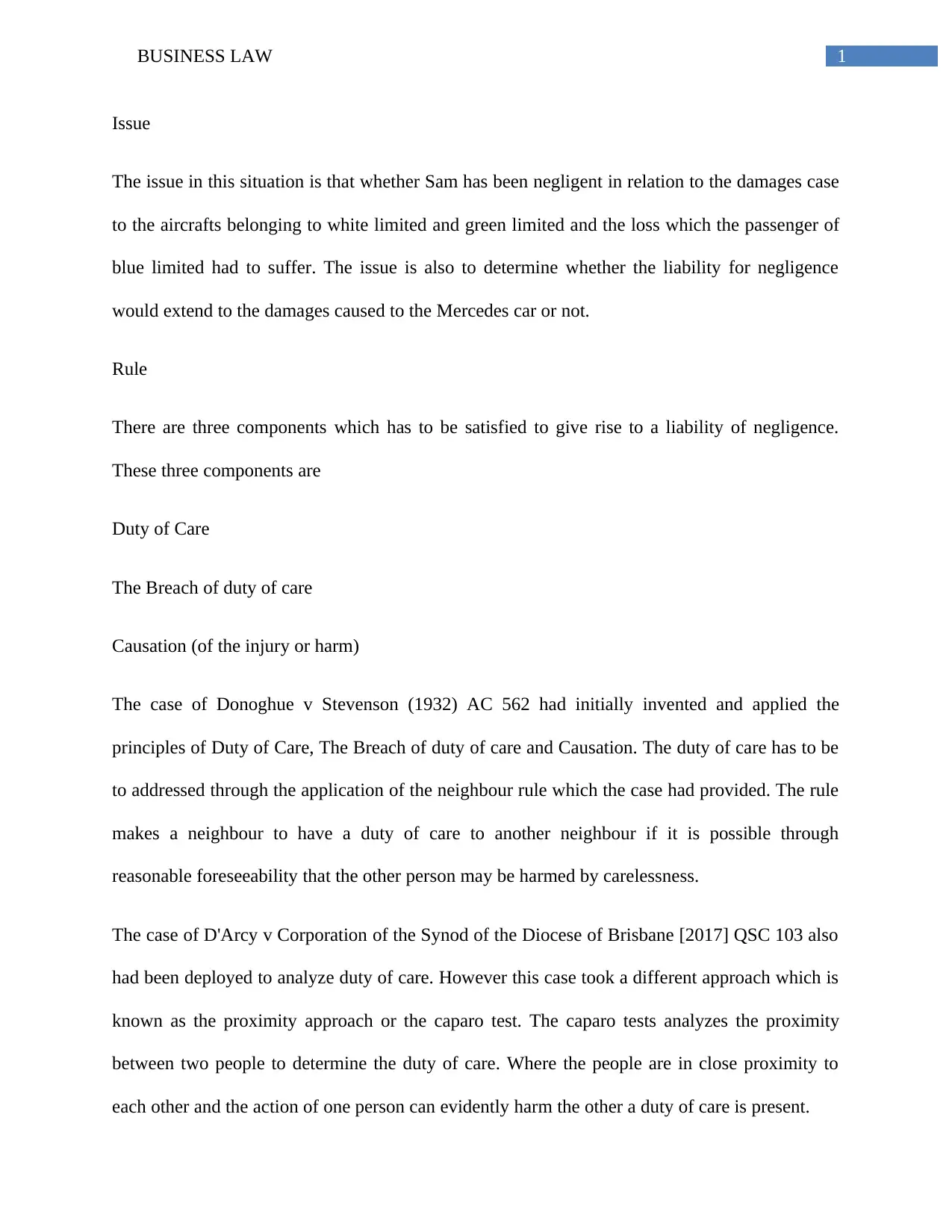
1BUSINESS LAW
Issue
The issue in this situation is that whether Sam has been negligent in relation to the damages case
to the aircrafts belonging to white limited and green limited and the loss which the passenger of
blue limited had to suffer. The issue is also to determine whether the liability for negligence
would extend to the damages caused to the Mercedes car or not.
Rule
There are three components which has to be satisfied to give rise to a liability of negligence.
These three components are
Duty of Care
The Breach of duty of care
Causation (of the injury or harm)
The case of Donoghue v Stevenson (1932) AC 562 had initially invented and applied the
principles of Duty of Care, The Breach of duty of care and Causation. The duty of care has to be
to addressed through the application of the neighbour rule which the case had provided. The rule
makes a neighbour to have a duty of care to another neighbour if it is possible through
reasonable foreseeability that the other person may be harmed by carelessness.
The case of D'Arcy v Corporation of the Synod of the Diocese of Brisbane [2017] QSC 103 also
had been deployed to analyze duty of care. However this case took a different approach which is
known as the proximity approach or the caparo test. The caparo tests analyzes the proximity
between two people to determine the duty of care. Where the people are in close proximity to
each other and the action of one person can evidently harm the other a duty of care is present.
Issue
The issue in this situation is that whether Sam has been negligent in relation to the damages case
to the aircrafts belonging to white limited and green limited and the loss which the passenger of
blue limited had to suffer. The issue is also to determine whether the liability for negligence
would extend to the damages caused to the Mercedes car or not.
Rule
There are three components which has to be satisfied to give rise to a liability of negligence.
These three components are
Duty of Care
The Breach of duty of care
Causation (of the injury or harm)
The case of Donoghue v Stevenson (1932) AC 562 had initially invented and applied the
principles of Duty of Care, The Breach of duty of care and Causation. The duty of care has to be
to addressed through the application of the neighbour rule which the case had provided. The rule
makes a neighbour to have a duty of care to another neighbour if it is possible through
reasonable foreseeability that the other person may be harmed by carelessness.
The case of D'Arcy v Corporation of the Synod of the Diocese of Brisbane [2017] QSC 103 also
had been deployed to analyze duty of care. However this case took a different approach which is
known as the proximity approach or the caparo test. The caparo tests analyzes the proximity
between two people to determine the duty of care. Where the people are in close proximity to
each other and the action of one person can evidently harm the other a duty of care is present.

2BUSINESS LAW
The case of Corporation of the Synod of the Diocese of Brisbane v Greenway [2017] QCA 103
discussed provisions used to identify a breach of the duty of care. The approach which had been
taken by this case is known as the objective test. The person who had a duty of care is replaced
with a hypothetical reasonable person and then the actions of such person is compared to the
person having duty of care. If the actions are reasonable then there is no breach and in case they
are not there is a breach. The reasonability of actions is based on factors like probability and
seriousness of the injury and the burden of taking precautions as per section 5C of the Civil
Liability Act 2002. It is to be noted as per the case of Stokes v House With No Steps [2016] QSC
79 that the person does not have the obligation of preventing the harm, the obligation is actually
to take reasonable care.
The case of Liverpool Catholic Club Ltd v Moor [2014] NSWCA 394 analyzed the rules relating
to causation. In this case it had been stated by the court that the injury if not caused where there
is no breach of duty and the sole reason for the damage is the breach of duty the person has
caused “causation” the test applied is known as but for test.
Damages are a significant part of the tort or negligence. In the case of Chaina v Presbyterian
Church (NSW) Property Trust (No. 25) [2014] NSWSC 518 it had been clarified by the court
that a person would only be able to claim damages which are reasonably foreseeable.
Contributory negligence is the defence which is applied to limit a liability of negligence. The
rule had been deployed in the case of Astley v Austrust Ltd (1999) 14 JCL 251,
260. The case stated that when a person has not taken reasonable care to avoid the injury they are
negligent themselves in a contributory manner and the damages to be provided to them are
reduced with reference to the contributions made by them.
The case of Corporation of the Synod of the Diocese of Brisbane v Greenway [2017] QCA 103
discussed provisions used to identify a breach of the duty of care. The approach which had been
taken by this case is known as the objective test. The person who had a duty of care is replaced
with a hypothetical reasonable person and then the actions of such person is compared to the
person having duty of care. If the actions are reasonable then there is no breach and in case they
are not there is a breach. The reasonability of actions is based on factors like probability and
seriousness of the injury and the burden of taking precautions as per section 5C of the Civil
Liability Act 2002. It is to be noted as per the case of Stokes v House With No Steps [2016] QSC
79 that the person does not have the obligation of preventing the harm, the obligation is actually
to take reasonable care.
The case of Liverpool Catholic Club Ltd v Moor [2014] NSWCA 394 analyzed the rules relating
to causation. In this case it had been stated by the court that the injury if not caused where there
is no breach of duty and the sole reason for the damage is the breach of duty the person has
caused “causation” the test applied is known as but for test.
Damages are a significant part of the tort or negligence. In the case of Chaina v Presbyterian
Church (NSW) Property Trust (No. 25) [2014] NSWSC 518 it had been clarified by the court
that a person would only be able to claim damages which are reasonably foreseeable.
Contributory negligence is the defence which is applied to limit a liability of negligence. The
rule had been deployed in the case of Astley v Austrust Ltd (1999) 14 JCL 251,
260. The case stated that when a person has not taken reasonable care to avoid the injury they are
negligent themselves in a contributory manner and the damages to be provided to them are
reduced with reference to the contributions made by them.
⊘ This is a preview!⊘
Do you want full access?
Subscribe today to unlock all pages.

Trusted by 1+ million students worldwide
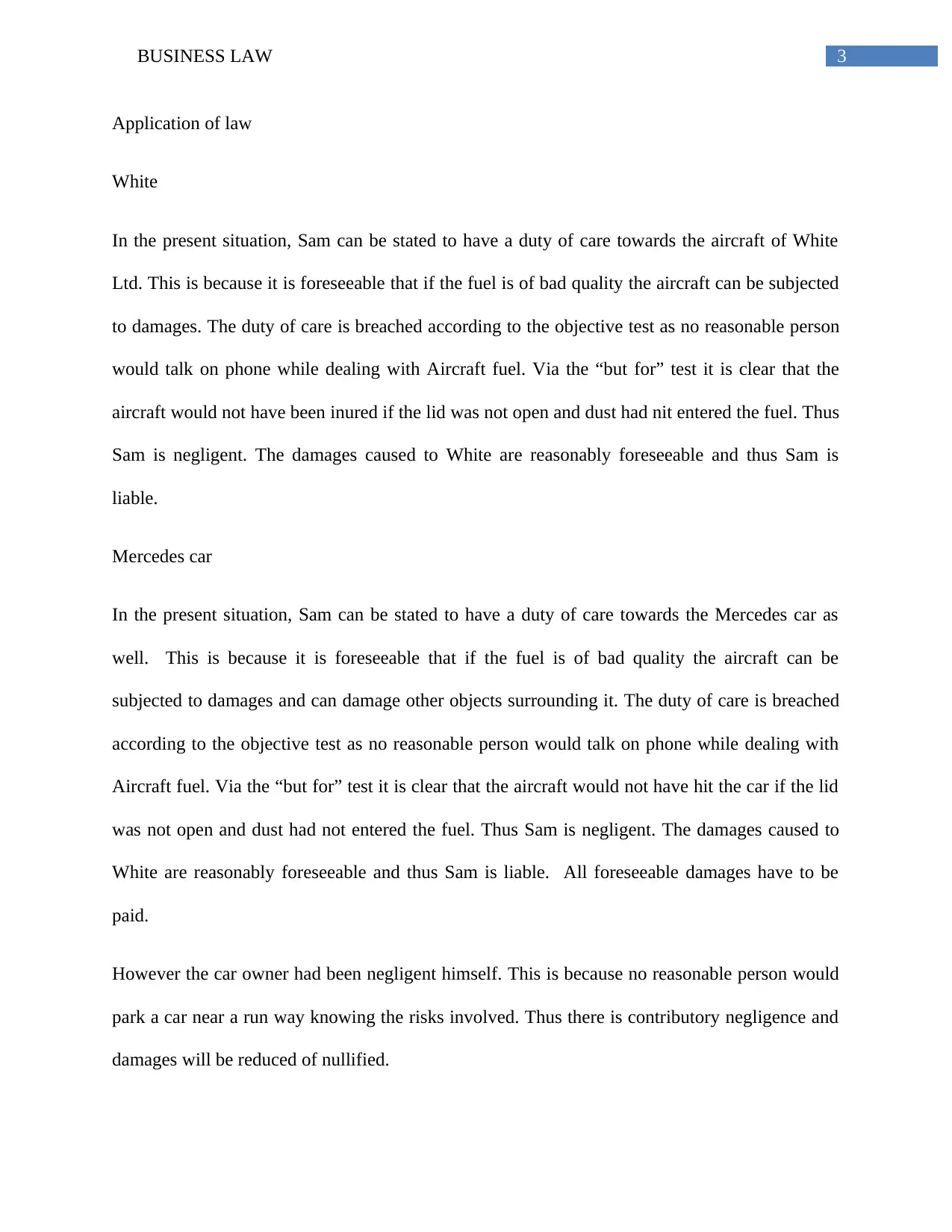
3BUSINESS LAW
Application of law
White
In the present situation, Sam can be stated to have a duty of care towards the aircraft of White
Ltd. This is because it is foreseeable that if the fuel is of bad quality the aircraft can be subjected
to damages. The duty of care is breached according to the objective test as no reasonable person
would talk on phone while dealing with Aircraft fuel. Via the “but for” test it is clear that the
aircraft would not have been inured if the lid was not open and dust had nit entered the fuel. Thus
Sam is negligent. The damages caused to White are reasonably foreseeable and thus Sam is
liable.
Mercedes car
In the present situation, Sam can be stated to have a duty of care towards the Mercedes car as
well. This is because it is foreseeable that if the fuel is of bad quality the aircraft can be
subjected to damages and can damage other objects surrounding it. The duty of care is breached
according to the objective test as no reasonable person would talk on phone while dealing with
Aircraft fuel. Via the “but for” test it is clear that the aircraft would not have hit the car if the lid
was not open and dust had not entered the fuel. Thus Sam is negligent. The damages caused to
White are reasonably foreseeable and thus Sam is liable. All foreseeable damages have to be
paid.
However the car owner had been negligent himself. This is because no reasonable person would
park a car near a run way knowing the risks involved. Thus there is contributory negligence and
damages will be reduced of nullified.
Application of law
White
In the present situation, Sam can be stated to have a duty of care towards the aircraft of White
Ltd. This is because it is foreseeable that if the fuel is of bad quality the aircraft can be subjected
to damages. The duty of care is breached according to the objective test as no reasonable person
would talk on phone while dealing with Aircraft fuel. Via the “but for” test it is clear that the
aircraft would not have been inured if the lid was not open and dust had nit entered the fuel. Thus
Sam is negligent. The damages caused to White are reasonably foreseeable and thus Sam is
liable.
Mercedes car
In the present situation, Sam can be stated to have a duty of care towards the Mercedes car as
well. This is because it is foreseeable that if the fuel is of bad quality the aircraft can be
subjected to damages and can damage other objects surrounding it. The duty of care is breached
according to the objective test as no reasonable person would talk on phone while dealing with
Aircraft fuel. Via the “but for” test it is clear that the aircraft would not have hit the car if the lid
was not open and dust had not entered the fuel. Thus Sam is negligent. The damages caused to
White are reasonably foreseeable and thus Sam is liable. All foreseeable damages have to be
paid.
However the car owner had been negligent himself. This is because no reasonable person would
park a car near a run way knowing the risks involved. Thus there is contributory negligence and
damages will be reduced of nullified.
Paraphrase This Document
Need a fresh take? Get an instant paraphrase of this document with our AI Paraphraser
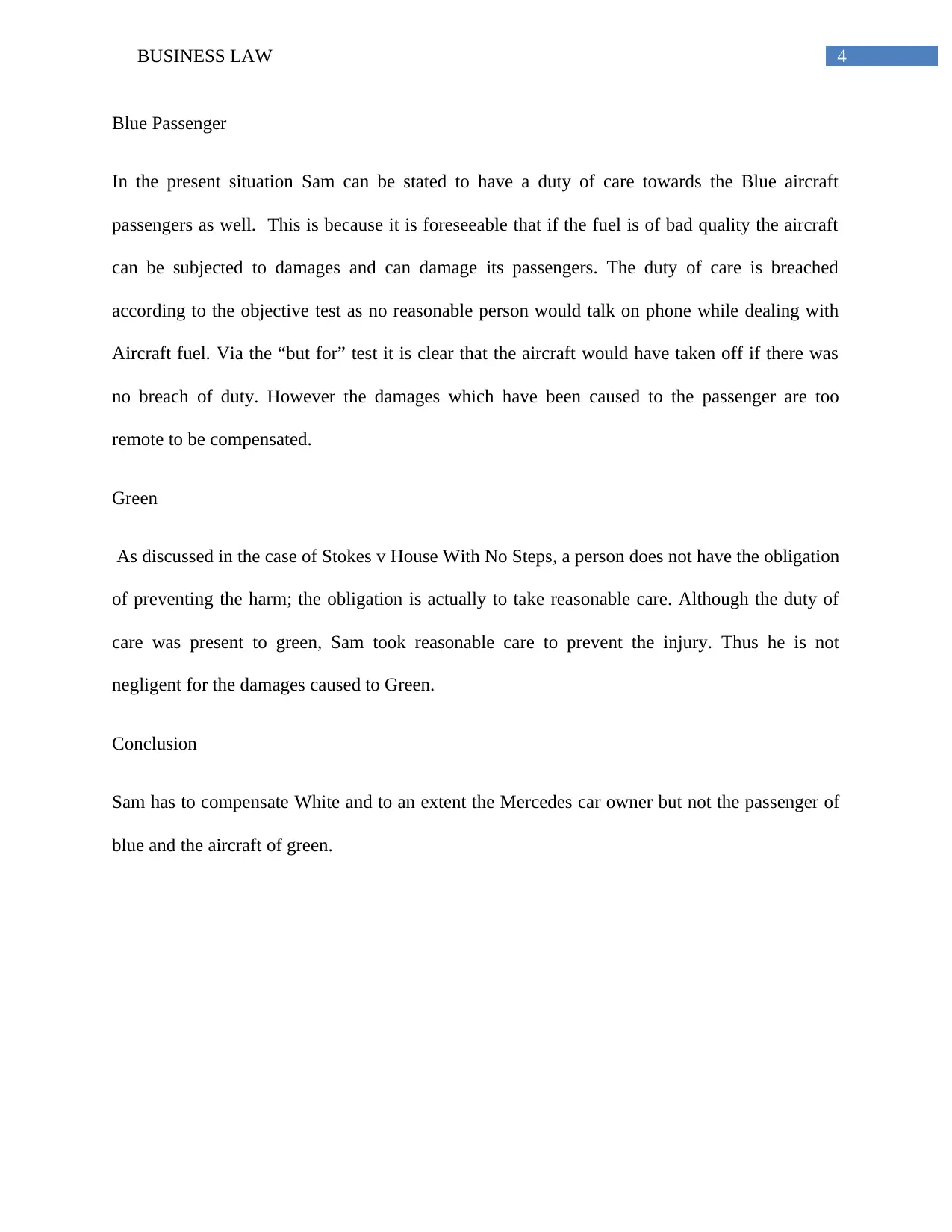
4BUSINESS LAW
Blue Passenger
In the present situation Sam can be stated to have a duty of care towards the Blue aircraft
passengers as well. This is because it is foreseeable that if the fuel is of bad quality the aircraft
can be subjected to damages and can damage its passengers. The duty of care is breached
according to the objective test as no reasonable person would talk on phone while dealing with
Aircraft fuel. Via the “but for” test it is clear that the aircraft would have taken off if there was
no breach of duty. However the damages which have been caused to the passenger are too
remote to be compensated.
Green
As discussed in the case of Stokes v House With No Steps, a person does not have the obligation
of preventing the harm; the obligation is actually to take reasonable care. Although the duty of
care was present to green, Sam took reasonable care to prevent the injury. Thus he is not
negligent for the damages caused to Green.
Conclusion
Sam has to compensate White and to an extent the Mercedes car owner but not the passenger of
blue and the aircraft of green.
Blue Passenger
In the present situation Sam can be stated to have a duty of care towards the Blue aircraft
passengers as well. This is because it is foreseeable that if the fuel is of bad quality the aircraft
can be subjected to damages and can damage its passengers. The duty of care is breached
according to the objective test as no reasonable person would talk on phone while dealing with
Aircraft fuel. Via the “but for” test it is clear that the aircraft would have taken off if there was
no breach of duty. However the damages which have been caused to the passenger are too
remote to be compensated.
Green
As discussed in the case of Stokes v House With No Steps, a person does not have the obligation
of preventing the harm; the obligation is actually to take reasonable care. Although the duty of
care was present to green, Sam took reasonable care to prevent the injury. Thus he is not
negligent for the damages caused to Green.
Conclusion
Sam has to compensate White and to an extent the Mercedes car owner but not the passenger of
blue and the aircraft of green.
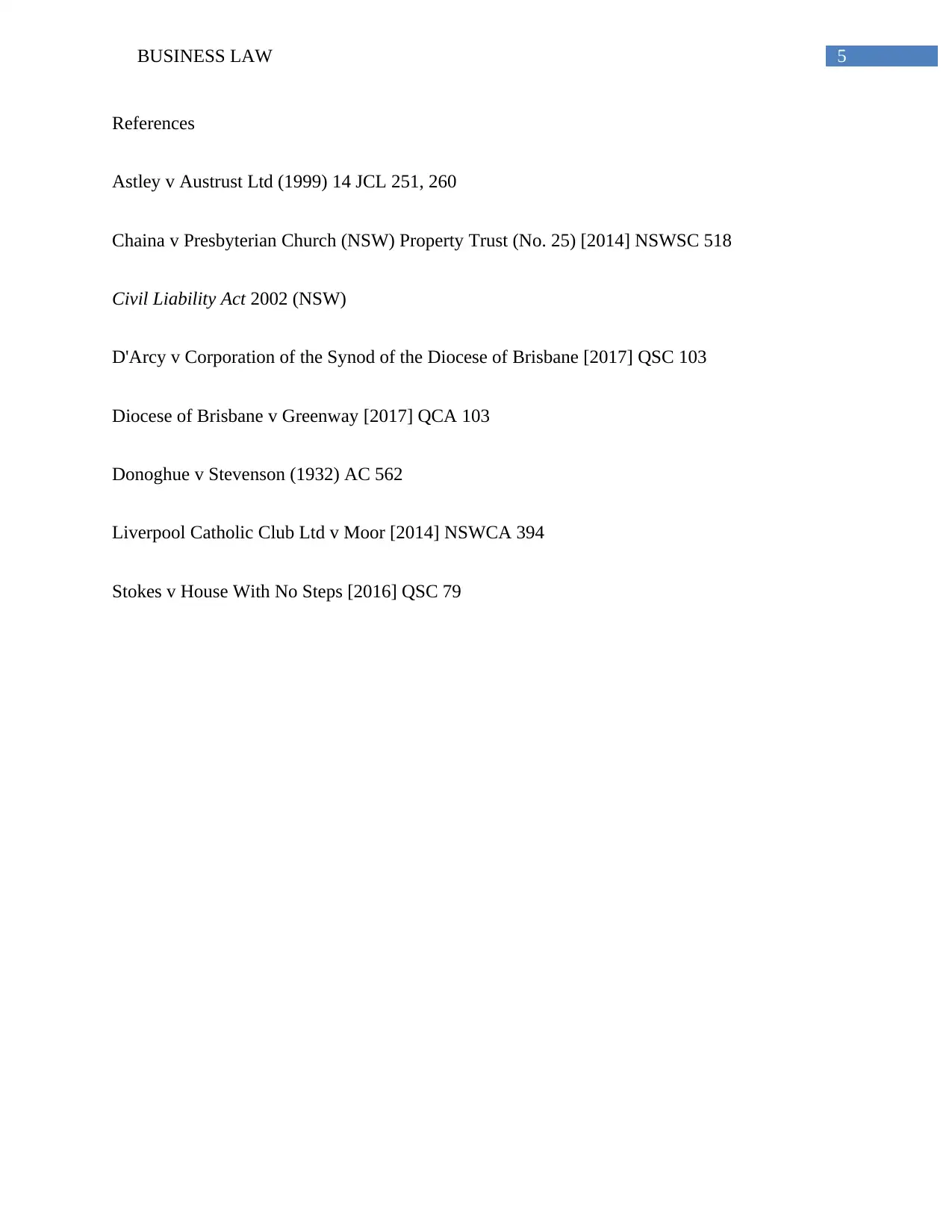
5BUSINESS LAW
References
Astley v Austrust Ltd (1999) 14 JCL 251, 260
Chaina v Presbyterian Church (NSW) Property Trust (No. 25) [2014] NSWSC 518
Civil Liability Act 2002 (NSW)
D'Arcy v Corporation of the Synod of the Diocese of Brisbane [2017] QSC 103
Diocese of Brisbane v Greenway [2017] QCA 103
Donoghue v Stevenson (1932) AC 562
Liverpool Catholic Club Ltd v Moor [2014] NSWCA 394
Stokes v House With No Steps [2016] QSC 79
References
Astley v Austrust Ltd (1999) 14 JCL 251, 260
Chaina v Presbyterian Church (NSW) Property Trust (No. 25) [2014] NSWSC 518
Civil Liability Act 2002 (NSW)
D'Arcy v Corporation of the Synod of the Diocese of Brisbane [2017] QSC 103
Diocese of Brisbane v Greenway [2017] QCA 103
Donoghue v Stevenson (1932) AC 562
Liverpool Catholic Club Ltd v Moor [2014] NSWCA 394
Stokes v House With No Steps [2016] QSC 79
⊘ This is a preview!⊘
Do you want full access?
Subscribe today to unlock all pages.

Trusted by 1+ million students worldwide
1 out of 6
Related Documents
Your All-in-One AI-Powered Toolkit for Academic Success.
+13062052269
info@desklib.com
Available 24*7 on WhatsApp / Email
![[object Object]](/_next/static/media/star-bottom.7253800d.svg)
Unlock your academic potential
Copyright © 2020–2025 A2Z Services. All Rights Reserved. Developed and managed by ZUCOL.





